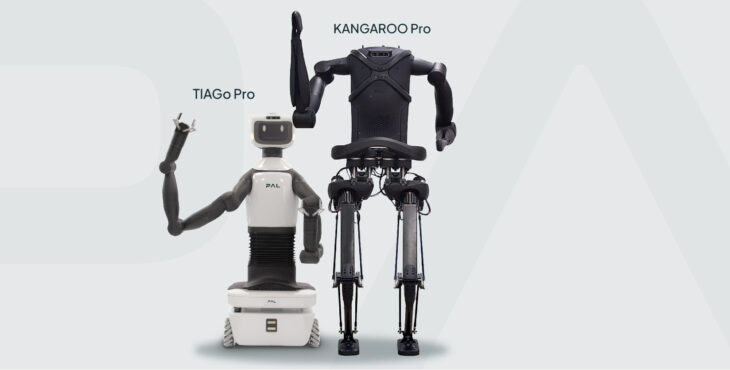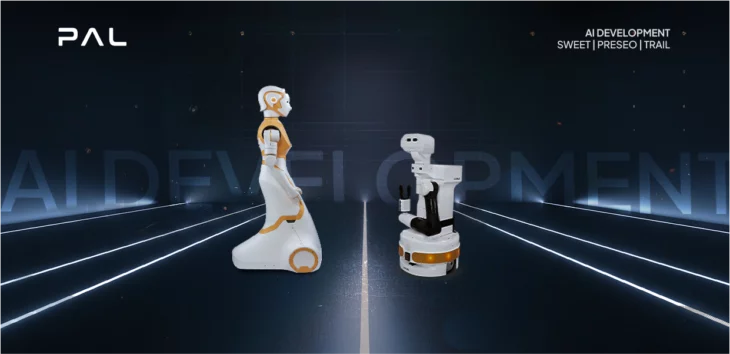The mobile manipular TIAGo robot and the factory of the future
The growth of Industry 4.0 is having a major impact on the manufacturing sector, bringing with it both opportunities and challenges. Some of the challenges are in areas such as safety, cybersecurity, and cyber-physical systems. The ongoing implementation of robots in industry 4.0 also sheds light on the need for stronger processes to enable robots and humans to work together, collaboratively. Robots in the context of the Factory of the Future are referred to as cobots and the field that studies the deployment of such platforms in industry as cobotics.
In response, and through the projects CyberFactory#1 and SeCoIIA, PAL Robotics has developed features on TIAGo robot to reflect this, focusing on areas including fleet management, anomaly detection, and learning by demonstration.
CyberFactory#1 is an EU collaborative project that aims to develop and optimise Factories of the Future for success. Furthermore, the project proposes preventive and reactive capabilities to address security and safety concerns, such as, blended cyber-physical threats, manufacturing data theft or adversarial machine learning.
The SeCoIIA EU project aims to ensure the digital transition of the manufacturing industry towards more flexible, connected and automated production techniques. As a result, this will lead to the task of developing an algorithm for early warning on deviation of human-machine interactions on the shop floor.
The tasks cobots are expected to perform are low-added value yet repetitive tasks. These can vary among the sectors in industry, and range from tasks that require some level of dexterity to tasks related to inventory and intralogistics. In response to the requirements of industry 4.0, apart from the ability to perform specific tasks, safety and cybersecurity have become primary areas of focus in cobotics.
Through projects CyberFactory#1 and SeCoIIA, PAL Robotics has contributed to the field by developing tools, on the one hand for the robots in the TIAGo family so that they can handle these low-added and repetitive tasks, and on the other hand to ensure that the TIAGo robot works safely alongside people in the Factory of the Future. The developed demonstrators are also grounds for cybersecurity experts in the consortiums of both projects to assess and evaluate the possible cyber threats and to find mitigation strategies for them.
CyberFactory#1 pilots including automating food production and digitalizing textile production
In CyberFactory#1 key capabilities are mapped in relevant application scenarios and their usability is verified in realistic use cases, reflecting the variety of possible new factory types like user-centric plants or learning factories and taking into account business model shifts like turning products into services or developing data services on top of manufacturing activities.
The project has included several pilots in transportation, automotive, electronics, and machine manufacturing industries. For example:
- High Metal – development of an automated food production line
- IDEPA– digitalizing a textile production line (legacy machines) for the automotive industry.
- Bittium – cyber-secure networked supply chain and information architecture.
- Airbus Defence & Space (Spain) – deployment of IIoT in the Aerospace Industry.
- Vestel – optimization of material handling in PCB assembly lines.
- Bombardier Transportation – optimising the material supply for rail vehicle production.
- ASTI – optimization of an autonomous transport robot fleet (ProANT)
- S21Sec – Human/Machine collaboration in manufacturing for quality control.
CyberFactory#1 is an international joint EU project with 28 partners from seven countries (Canada, Finland, France, Germany, Portugal, Spain and Turkey).
SeCoIIA pilots including smart detection agents and cyber monitoring
In order to automate further the production line, more flexible and collaborative robots are needed, the SeCoIIA project has focused their pilots on this topic. In the aerospace industry the project is piloting collaborative robots that are ready to support human operations in drilling. Whilst, in the maritime industry, an industrial robotic arm is being used for laser cutting of metal ship hulls, along with smart detection agents and cyber monitoring.
The involvement of collaborative robots, aims at reducing the share of manual activities of lower added value which at the state of the art constitute 70% of manufacturing tasks still in the aerospace domain, a little less in the automotive and maritime domains. Expected benefits of this industrial use case are lead time reduction, waste reduction, and shop floor logistics cost reduction. The key challenge here is to secure the collaboration between humans and robots which should operate in non-segregated shop-floor spaces.
PAL Robotics takes part in the SeCoIIA EU project with 10 partners from across Europe: Airbus FR, Continental DE, Naval Group FR, Airbus DE, ISEP Institute, The Fraunhofer Institute, VTT Technical Research Centre FI, The KU Leuven Centre for IT and IP Law Belgium, SystemX FR, SISTRADE Software Portugal, and Forescout Technologies.
Demonstrating TIAGo’s capabilities as a cobot within CyberFactory#1 and SeCoIIA
When bringing a platform like TIAGo to the shop floor, in the sectors of the partners of the SeCoIIA and CyberFactory#1 projects, the robots should include the features and capabilities that make them useful in context. These capabilities can be split into three main groups:
- Automated logistics and inventory activities. This contains solutions for intralogistics and task scheduling.
- Learning by Demonstration. This consists of solutions that allow teaching the robotic arm by performing the task once with the robot.
- Lone worker protection. This contains any tool that is aimed at enhancing the safety features of the cobot.
The developments done in the context of SeCoIIA and CyberFactory#1 can be put in these three groups.
To deal with automated logistics and inventory activities, a fleet management system has been developed. This allows an ensemble of robots to work together as a fleet, bringing the group self-awareness. A corollary of this is the solution to the Machine to Machine interaction level, as the communication challenge between robots is solved. It is worth noting that apart from navigating tasks, any other tasks that can be done with the robots can be done in a synchronised manner.
To deal with learning by demonstration, a module based on Dynamic Motion Primitives has been integrated, together with an easy-to-use interface for non-robotics expert workers. This allows the worker to teach the robot motions with the arm with a high degree of adaptability.
And finally, to ensure the protection of the loan worker, different tools have been developed. All of the following are based on Machine Learning techniques. For the robotic arm, an anomaly detection module has been developed. This enables ensuring safety in taught motions. It is also possible to monitor the emotions of workers using the TIAGo built-in cameras. And finally, the usage of the web-commander of the TIAGo robot can be probed to analyse human to Machine interaction.
The demonstrations to show the capabilities of cobots and test cybersecurity threats
The main goal of the demonstrations is twofold: on the one hand, they show the capabilities of cobots, and on the other hand, it has to serve as the grounds to assess and test possible cybersecurity threats such a deployment may be up to.
The demonstration consists of two robots that were controlled as a fleet. This only allows controlling both robots at the same time but also provides the TIAGo robots with self-awareness as an ensemble. Before the robots start navigating, a task for each of them is taught and recorded by the learning by demonstration module.
One task is done before the other, and a major task that consists of these two tasks is done once the robots have performed their own. This is why the robots are sent, one after the other, to a prescribed number of different locations. The fleet features allow knowing when each of the robots has arrived at their location, finished their task, etc. This allows for performing high-level tasks in a synchronised manner.
It is worth mentioning that there is a focus on two relevant aspects. On the one hand, we have human-centricity: the role of cobots is to collaborate with humans, and they are also meant to be able to interact with humans. And on the other hand, we have the resilience of the European Industry. The developments put together give a glimpse of what a human-robot relationship in the industry of the future may be.
Combining perception, navigation, manipulation & HRI in TIAGo robot
TIAGo robot combines perception, navigation, manipulation & Human-Robot Interaction skills out of the box. TIAGo robot has a modular design and can be configured based on our customers’ needs. The arm has a large manipulation workspace, being able to reach the ground as well as high shelves. The end effector can be a gripper or a humanoid hand and they can be quickly exchanged for performing various manipulation tasks.
We are happy to have developed features on TIAGo through these projects that bring us one step closer to implementation in the Factory of the Future. Find out more about EU-funded projects Cyberfactory#1 and SeCoIIA. If you would like to talk more about collaborative projects and ways to work together, do not hesitate to get in touch with us. To learn about the capabilities of our mobile manipulator, TIAGo and AMR, TIAGo Base take a look at our website and don’t forget to take a look at our blog specialised in robotics!


